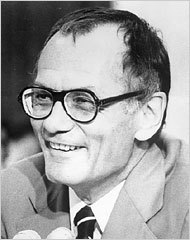
|
| ©George C. Marshall Institute |
| Robert Jastrow |
The cause was complications of pneumonia, according to an announcement from the George C. Marshall Institute in Washington, the policy institute Dr. Jastrow helped found in 1984 after 20 years as head of NASA's Goddard Institute for Space Studies in New York, a unit of the Goddard Space Flight Center in Greenbelt, Md.
In an age when scientists tended to keep to their laboratories and lecture halls, Dr. Jastrow was a very public figure, a prolific author and commentator on a wide range of topics including the space program, astronomy, earth science and national security issues. He lectured on CBS and NBC about space, and his 1967 book "Red Giants and White Dwarfs" was a best seller for a nation hungering for an accessible guide to science during the space race.
"He had a deep sense of the need to interpret science and make it available to the public," said Albert Arking, a former student of Dr. Jastrow. As an ambassador of science, he was a natural, Dr. Arking recalled, saying, "His enthusiasm for science was infectious."
His descriptions were sharp and his language clear. In an article he wrote in August 1969 while he was director of the Goddard Institute, he described the 50 pounds of rocks and soil that the Apollo 11 astronauts brought back to earth as a "Rosetta Stone" of the history of the solar system. Without the erosive properties of air and water that have turned the surface of the earth into a kind of palimpsest, an over-written document that hides all but glimpses of its history, the surface of the moon, he said, "has preserved the record of its past for an exceptionally long time."
Dr. Jastrow was born in 1925 in New York, and earned undergraduate and doctoral degrees in physics at Columbia University. In 1958, he joined the newly formed National Aeronautics and Space Administration as head of its theoretical division, which did basic research in fields like cosmology and astronomy.
With the encouragement of Harold Urey, a Nobel laureate at NASA at the time, Dr. Jastrow became an energetic proponent of lunar exploration. In 1961, he became director of the Goddard Institute for Space Studies, which worked within the agency on projects like the robotic probes Pioneer, Voyager and Galileo, which sailed throughout the solar system.
In 1992, he became chairman of the Mount Wilson Institute, which runs the Mount Wilson Observatory in California, and in 1984 he helped found the George C. Marshall Institute, which took positions in public debates over science policy. He was chairman emeritus of the institute at his death.
He received the NASA Medal for Exceptional Scientific Achievement and the Arthur S. Flemming Award for Outstanding Service to the United States Government, as well as the Columbia University Medal of Excellence.
He was briefly married in 1967 to the former Ruth Witenberg. He leaves no immediate survivors, the Marshall Institute said.
A competitive athlete who was "a bit reckless" as a skier, Dr. Arking said, Dr. Jastrow was driven to work as hard as he played, often working all night to finish projects and expecting his staff to do the same. He would often pull his colleagues out of the office to run with him around the Central Park Reservoir.
Later in life, as chairman of the Marshall Center, Dr. Jastrow blended the scientific with the political, often, colleagues said, in response to what he saw as efforts by others to politicize science. In 1985, he published "How to Make Nuclear Weapons Obsolete," a book supporting President Ronald Reagan's Strategic Defense Initiative, known as the Star Wars missile defense system.
Dr. Jastrow also became a prominent skeptic on climate change issues, arguing that scientists who warned of a global warming crisis were misattributing nature's effects on climate to the effects of mankind. Dr. Arking, a climate scientist at John Hopkins University who continued to visit his old mentor on a regular basis until two days before his death, recalled arguing the issue with Dr. Jastrow, finding him less and less willing to make any concessions in their discussions.
"I tried to dissuade him on some issues," Dr. Arking said, recalling that Dr. Jastrow responded: "Yeah, you're probably right, but this is the way we have to put it. We have to convince people that this is not the catastrophe that people were making it out to be."



Comment: How ironic that Jastrow, skeptic of anthropogenic global warming, headed the very institute that now is a major player in promoting it, with James Hansen as its head. What's even more ironic - and left out in the above obituary - not surprisingly - is that Robert Jastrow was a vocal skeptic of Carl Sagan's attack on Immanuel Velikovsky, author of Worlds in Collision, who, using comparative mythology and ancient literary sources argued that Earth has suffered catastrophic close encounters with other planets in ancient times. Now we know that these contacts were most probably cometary encounters and not planetary. However Jastrow wrote of Velikovsky in Science Digest Sep/Oct 1980: In Sagan's attack on Velikovsky, Robert Anton Wilson writes in "Cosmic Trigger": Of course, Carl Sagan, not to be outdone, replied to Jastrow's letter by calling it 'scientific incompetence'. However, as comet Shoemaker-Levy crashed into Jupiter in July 1994, 29 months before Sagan's death, it was Velikovsky and Jastrow who got the last laugh, if one could laugh at such a cosmic catastrophe clearly threatening our planet.